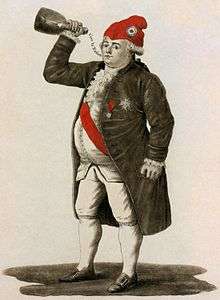Culottes


Culottes are an item of clothing, originally the knee-breeches commonly worn by gentlemen of the European upper-classes from the late Middle Ages or Renaissance through the early nineteenth century. This style of tight trousers ending just below the knee was first popularized in France during the reign of Henry III (1574–1589).[1] Culottes were normally closed and fastened about the leg, to the knee, by buttons, a strap and buckle, or a draw-string. During the French Revolution of 1789–1799, working-class revolutionaries were known as the "sans-culottes" – literally, "without culottes" – a name derived from their rejection of aristocratic apparel.[2] In the United States, only the first five Presidents, from George Washington through James Monroe, wore culottes according to the style of the late 18th century.[3][4]
In military uniforms
Military uniforms incorporated culottes as a standard uniform article, the lower leg being covered by either stockings, leggings, or knee-high boots. Culottes were a common part of military uniforms during the European wars of the eighteenth-century (the Great Northern War, the War of the Spanish Succession, the War of the Austrian Succession, the Seven Years' War, the Franco-British Colonial Wars, and the American Revolution).
Later definitions
The women's fashion industry commonly takes words that have historically been used to describe men's garments and uses them to describe an entirely different garment, often creating confusion among historians and history students and readers. For example, currently, the term "culottes" in French is now used to describe women's panties, an article of clothing that has little or no relation to the historic culottes. The term "sans-culottes" has been used to refer colloquially to mean "going commando" or not wearing panties.[5]

Women's culottes
Another latter-day use of the word culottes describes a split or bifurcated skirt[6] or any garment which "hangs like a skirt, but is actually pants."[1] During the Victorian Era (mid- to late-nineteenth century) long split skirts were developed for horseback riding so that women could sit astride a man's saddle rather than riding side-saddle. The term "culottes" was co-opted from the original French definition of the word to describe these split riding skirts. Later, split skirts were developed to provide women more freedom to do activities such as gardening, cleaning, bike riding, etc. and still look like one is wearing a skirt.[7]
Skorts
In place of the term culotte, the term skort (a portmanteau for skirt and shorts) is more widely used in some areas. While some garments sold as culottes resemble short trousers, to truly be a skort it needs to look like a skirt. Thus, they differ from trousers or shorts by being much fuller at the bottom (hem) than at the waist. A skort is shorts that have a front covering to resemble a skirt[8] or short pant legs with a same length or longer skirt sewn over the top.[9]
Some culottes have a part sewn over only the front, some are shorts with a skirt sewn over them. While these may not be completely the same, they are often called by either name, so either term can apply.
School uniforms
Culottes are used in school uniforms for girls. They can be used along with skirts, or they may be used as a replacement for skirts. Culottes are worn as part of a uniform mainly to primary and middle schools. Culottes were also part of the uniform of UK Brownie Guides [10] up until recently, when the uniform was modernised and the traditional brown culottes (and the navy blue culottes worn by the Girl Guides) were replaced.
References
- 1 2 Calasibetta, Charlotte Mankey; Tortora, Phyllis (2010). The Fairchild Dictionary of Fashion (PDF). New York: Fairchild Books. ISBN 978-1-56367-973-5. Retrieved 2011-02-17.
- ↑ Soboul, Albert (1972). The Sans-Culottes: The Popular Movement and Revolutionary Government, 1793–1794. New York: Doubleday. p. 2–3. ISBN 0-691-00782-9. Retrieved 2011-02-17.
- ↑ Digital History, Steven Mintz. "Digital History". Digitalhistory.uh.edu. Retrieved April 20, 2010.
- ↑ Real Life at the White House: 200 ... – Google Knihy. Books.google.cz. Retrieved April 20, 2010.
- ↑ "sans-culotte", Passons de la sans-soutif de l'Upper East Side à la sans-culotte de Times Square,
And from no bra on the Upper East Side ... ... to no panties in Times Square.
- ↑ WordNet Search - 3.0
- ↑ Culottes Skirt is a Skort
- ↑ Fashion Design Schools - Glossary of Terms
- ↑ glossary
- ↑ Bedfordshire Guiding - History of Brownie Uniforms
| ||||||||||||||||||||||||||||||||||||||||||||||||||||||||||||||||||||||||